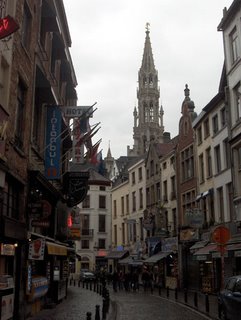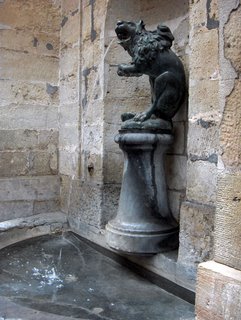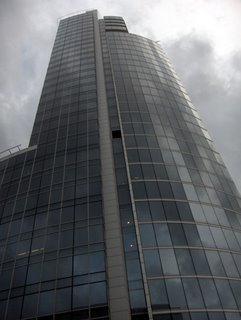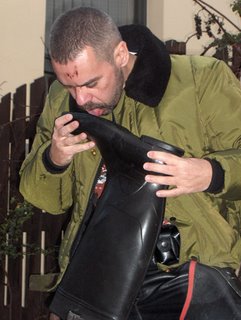Wednesday, May 31, 2006
Brussels: area by area: The Lower Town – Quartier Marolles

The centre of Brussels is enclosed within a rough pentagon of boulevards, a "petit ring" which follows the course of the fourteenth-century city walls. It is divided between the Upper and Lower Towns, the neighbourhoods generally becoming more expensive the higher you go.
By far the greater part of the centre is occupied by the Lower Town, the medieval core of which zeroes in on the Grand Place, the unquestionable centre of Brussels and perhaps the finest preserved city square in Europe.
South of here, the busy centre fades into the old working-class streets of the Marolles district and Gare du Midi, now a depressed, predominantly immigrant area; north, the shopping street of rue Neuve leads up to place Rogier and the tawdry area around the Gare du Nord.
Brussels: area by area: The Lower Town – Rue des Bouchers






The "Petite Rue des Bouchers" (street of the butchers) in the medieval center of Brussels is famous for the fact that every house in the street is a restaurant. The street is closed for traffic (anyway it is too narrow to let cars pass), and this allows the restaurants to exhibit some of their products (especially sea-food and fish) in a rather spectacular fashion in front of the passers-by. In some of the wider parts of the street it is also possible to eat and drink outside, watching the crowd strolling between the quaint, narrow houses.
The "Rue des Bouchers" is just a few minutes walking from the Grand' Place, the central market square of Brussels, which is said to be the most beautiful in the world. The square is dominated by the magnificent 15th century Town Hall, with its hundreds of little statues. Unfortunately, the most beautiful part of the Town Hall, the elegant tower, is hidden behind scaffolding, waiting for a much needed renovation. Even with the Town Hall in bad shape, the splendid 17th century buildings, with their golden inlays, surrounding the square, will certainly enchant you.
Brussels: area by area: The Lower Town – Halles St. Géry

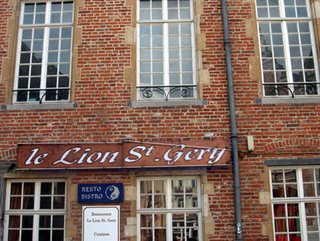





The new springs alive from the old here, as the revitalized area around the Halles Saint-Gery is now one of the trendiest neighbourhoods in Brussels. It is believed that that the very origin of Brussels stems from this area along the Senne River about a thousand years ago.
Let us begin with the Halles Saint-Gery, the marvellous centrepiece of this gentrifying area. This charming red brick building with its glass roof, by architect A. Vanderheggen Elles, was inaugurated as the local meat market in 1882. On the brink of demolition in 1982, it was renovated first as a shopping gallery and then recast in 1999 as a cultural centre and as a regional centre for the promotion of estate heritage. There are interesting exhibits ranging from architecture to a Tintin comic retrospective. The ground level houses offices with an environmental bent for conscientious locals to visit. An historic obelisk from 1802 sits in the middle of the ground level, and patrons can enjoy drinks at tables beside the monument. The lofty sky lit space, supported by attractive steel trusses, has a very lively atmosphere.
Just north of the Halles Saint-Gery is the Beursschouwburg, a promising new arts centre in a renovated complex with red and white interiors that will be “open to the artists and thinkers of tomorrow”. Art, music, dance, theatre, film and video will be the focus here, with a cafe that will feature free concerts on Thursday evenings. Just south of the Halles Saint-Gery is a wharf reconstruction of the Senne River, which in the past was unfortunately filled in and is now basically just an underground river. This small canal runs behind the Eglise Notre-Dame des Riches Claires (Church of Our Lady of Riches Claires), a heavily renovated church of red brick with an interesting Italian-Flemish Baroque style. The Riches Claires Auditorium across the street is a performance stage for a variety of concerts, plays and dance.
There are some very hip stores, restaurants and bars in this area, along with a few buildings that barely can be called Chinatown. The Halles Saint-Gery is just west of the Bourse and not far from the Grand Place. Try and check out this area while it is hot.
Brussels: area by area: The Lower Town – La Bourse I

At the stock exchange, the decorative frieze of allegorical statues in various stages of nudity, some of them by Rodin, forms a sort of idealization of the common man.
Trading here, as at most European stock exchanges, is via electronic computer screens, meaning that there is no longer a trading floor. Next door lies Bruxella 1238, an archaeological museum where you can inspect the excavation of a 13th-century church.
Brussels: area by area: The Lower Town – Théâtre Royal de la Monnaie

Theatre de la Monnaie - Place de la Monnaie
This neo classical opera house was the site of the Belgian uprising in 1830 when the audience were so inspired by the song "Sacred Love of the Fatherland" they rushed outside to join the protesting workers. Together they attacked the Dutch garrison and the flag of Brabant was raised. Belgium achieved independence within the year.
The beautiful ornate interior as well as the historical importance of the Opera House makes it well worth a visit.
Brussels: area by area: The Lower Town – Centre Belge de la Bande Dessinée

Belgian Centre of Comic Strip Art
The Waucquez Warehouses are considered to be one of the masterpieces of the most famous Belgian Art Nouveau architect, Victor HORTA. Horta built the house in 1906 for the Waucquez family who used it for a wholesale cloth business. The building displays beautifully the principles of Horta's architectural style: sunlight filters from the glass ceiling into the central hall, thereby illuminating the rest of the warehouse in a natural way. The Warehouses were restored between 1987 and 1989.
One of the most typical new art forms for Belgium are comic strips. After World War II, most of the Belgians have grown up with Belgian comic strips. One can say that there used to be two schools : the French-language comics ( =Bandes Dessinés) and the Flemish ones (stripverhalen).
Of the former, the name HERGE stands out as the most important writer. He is the father of the best known Belgian comic strip: TINTIN.
Willy VANDERSTEEN is the most known name of the Flemish school. His most important creation is SUSKE AND WISKE (in English known as Willy and Wanda). Since the 1950's, however, the entire comic strips scene has boomed in Belgium.
This beautiful museum illustrates this "9th art" in Belgium, with sets of enlarged drawings, three-dimensional recreations, etc. One can also learn everything about the birth and the development of a comic strip album. The museum also has a nice shop with albums and gadgets of the different Belgian comic strip heroes.
Location
Zandstraat / Rue des Sables, 20
1000 Brussels
Opening hours
From 10am to 6pm
Admission
Adults : 6,20 € (Euro) per person.
Brussels: area by area: The Lower Town – Place de Brouckère


This famous place constituted, until the accesses of 1970, a splendid architectural harmony. Unfortunately, this harmony was damaged by the skyscrapers of concrete and glass which overhang the place with the two corners of the Anspach boulevard. The place was created twenty years after the new central boulevards, after the demolition of the church of Augustins which occupied about half of the current place.


















